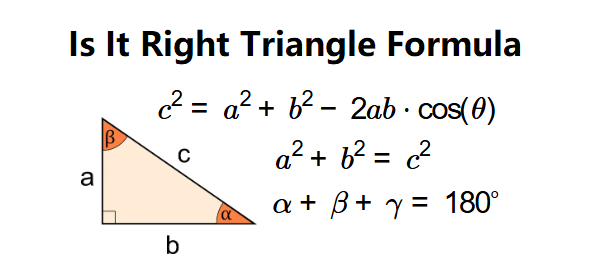1. What is the Is it a Right Triangle Calculator?
Definition: The Is it a Right Triangle Calculator determines whether a triangle is a right triangle (having one interior angle of 90°) based on three sides, two angles, or two sides and one angle.
Purpose: Assists in verifying triangle properties for geometry, construction, or educational purposes with customizable units for side lengths.
2. How Does the Calculator Work?
The calculator uses the following methods:
Method 1: Three Sides (Pythagorean Theorem):
\[ a^2 + b^2 = c^2 \]
Where \( c \) is the longest side (hypotenuse), and the triangle is right if this equation holds within a small tolerance.
Method 2: Two Angles:
\[ \alpha + \beta + \gamma = 180^\circ \]
The triangle is right if one angle is 90° (e.g., \(\alpha + \beta = 90^\circ\)).
Method 3: Two Sides and One Angle (Law of Cosines):
\[ c^2 = a^2 + b^2 - 2ab \cdot \cos(\theta) \]
The triangle is right if \(\theta = 90^\circ\) (where \(\cos(90^\circ) = 0\)).
Where:
- \( a, b, c \): Side lengths.
- \( \alpha, \beta, \gamma \): Angles in degrees.
- \( \theta \): Angle between sides \( a \) and \( b \).
Steps:
- Step 1: Choose Method. Select "Three Sides," "Two Angles," or "Two Sides and One Angle."
- Step 2: Enter Values. Input the required measurements (sides in selected units, angles in degrees).
- Step 3: Select Unit. Choose from cm, m, inch, feet, or yard (for sides method).
- Step 4: Calculate. Determine if the triangle is a right triangle.
3. Importance of Right Triangle Identification
Identifying a right triangle is crucial for:
- Geometry: Applying the Pythagorean theorem or trigonometric functions.
- Construction: Ensuring right-angled structures or supports.
- Education: Teaching triangle classification and properties.
4. Using the Calculator
Example 1: Sides 3 cm, 4 cm, 5 cm:
- Step 1: Method = Three Sides.
- Step 2: Sides = 3 cm, 4 cm, 5 cm.
- Step 3: Check \( 3^2 + 4^2 = 9 + 16 = 25 = 5^2 \) (within tolerance).
- Result: Yes (3-4-5 is a Pythagorean triple).
Example 2: Angles 45°, 45°:
- Step 1: Method = Two Angles.
- Step 2: Angles = 45°, 45°.
- Step 3: Sum = 45° + 45° = 90°, third angle = 90°.
- Result: Yes (isosceles right triangle).
Example 3: Sides 5 m, 12 m, Angle 90°:
- Step 1: Method = Two Sides and One Angle.
- Step 2: Sides = 5 m, 12 m, Angle = 90°.
- Step 3: Hypotenuse = \(\sqrt{5^2 + 12^2} = 13\) m, matches Pythagorean theorem.
- Result: Yes.
Example 4: Sides 2 cm, 3 cm, 4 cm:
- Step 1: Method = Three Sides.
- Step 2: Sides = 2 cm, 3 cm, 4 cm.
- Step 3: Check \( 2^2 + 3^2 = 4 + 9 = 13 \neq 16 = 4^2 \) (outside tolerance).
- Result: No (does not satisfy Pythagorean theorem).
5. Frequently Asked Questions (FAQ)
Q: What defines a right triangle?
A: A right triangle has one interior angle of 90°, with the longest side (hypotenuse) opposite this angle.
Q: Can a triangle have two right angles?
A: No, the sum of angles in a triangle is 180°, so only one can be 90°.
Q: What if the inputs are invalid?
A: The calculator will display an error message and disable calculation until valid inputs are provided.
Is it a Right Triangle Calculator© - All Rights Reserved 2025
 Home
Home
 Back
Back
